(A tutorial for those without half a century in the business, and a few with)
by Jim Tanenbaum CAS
IT’S OKAY TO LIE TO THE DIRECTOR … REALLY
In my UCLA classes, “Set Politics & Protocol” occupy more than 20% of the class time. No matter how good of a mixer you are, if there is an adversary relationship between Sound and Camera, it may be difficult or impossible to get good sound. Ditto for all the other departments.
Unfortunately, some directors make bad calls when asked to judge sound on the set. In the first place, most directors want to listen to the production track most of the time, but they don’t want to be encumbered more than absolutely necessary. Thus, the ubiquity of lightweight foam-padded open-air headphones. Getting most directors to wear even moderately-isolating closed-cup headphones is a losing battle. (On the rare occasion when they do, they often leave their dominant ear free.) Even worse, some young “mixers” no longer have learned how to mix anything, and simply crack all the pots open halfway through the entire take for the “scratch mix.” This results in many directors accepting an excessive amount of reverb and/or ambience mixed in with the (hopefully) clean dialog track iso as “normal,” so when there is a real problem of too much background or other undesirable noises in the production dialog, they are almost never aware of it.
Therefore, when I know there is a problem that makes the production track unusable, I have learned not to let the director (or producer) simply listen to it over my highly-isolating headphones because the lack of ambient bleed makes the track sound “better” to them. Invariably they will say: “That’s okay—we’ll fix it in post.” Some examples:
1. Excessive generator (or other localized-source) noise. Instead of letting the director hear it as it really is, I will have my boom op surreptitiously cue the mike toward the genny or other source, or open my slate mike, or otherwise degrade the mike’s signal so even a deaf director will know it’s no good.
2. Excessive room reverb. This is more difficult for the director to perceive because the human brain has dedicated echo-reducing circuits that operate subconsciously whenever stereo input from both ears is available. Listening normally doesn’t reveal the hollowness, so when the director does hear it in your headphones, their first reaction is: “There’s something wrong with your mike—look, it’s much closer to the actors than I am right now.” Teaching him or her Acoustics 101 before the first take is not an option. And even if it was, there won’t be time to pad all the off-camera walls, floor, and ceiling.
This is where your pre-production homework comes in. If you found out that this particular director always covers every line of dialog in closer shots, simply don’t bring up the issue at all. If Murphy’s Law intervenes and they don’t, ask for wild lines of the uncovered dialog. If the director objects, just say: It’s needed to match the covered dialog.” IMPORTANT: If you say anything with enough authority and certainty, most people will accept it without question (even if it’s wrong). Yes, there’s a slight risk that this procedure might fail, but risk-taking comes with the job. Remember: The most important thing experience teaches you is what you can get away with.
On the other hand, your research may reveal that this director doesn’t cover everything, and/or lets the actors improvise every take (in which case you may have much more serious problems to deal with). Now is when your location scouting pays off. Being aware of the parallel hard walls, no carpets on the floor, etc., you will have brought along a pile of sound blankets and your own mounting rigs (an extendable painter’s pole and a 6’ 1”x2” wood batten clamped in it at a right angle, will allow you to quickly jam one edge of the blanket against the ceiling, several inches to a foot away from the wall for maximum effectiveness). Also, you will have scoped out places to hide close-in plant mikes (remember that mounting them on a large hard surface eliminates any sound reflections from it—the Boundary-Layer Technique). And you will have short cardioid and super/hyper-cardioid mikes for low ceilings if they are present (remember that interference-tube shotgun mikes are not a good choice for reverberant spaces).
3. Excessive shoe or prop noises. Some directors, particularly older ones, understand the real reason for quieting these sounds: the regular cadence of heel clicks will be disrupted by intercutting between angles and takes, and they need to be replaced with uniformly-spaced Foley. The timing of noisy prop action may not match exactly from wide shot to close-up. Explaining all this takes time, and often exceeds the director’s attention span. This is another example of something you take care of ahead of time, without bothering the director. Should they ask, just give them the shortest, simplest, believable answer—whether it is accurate, or even remotely true, is irrelevant.
4. There are esthetic considerations that are beyond the pay grade of some directors. Here is a chance for the production mixer to make a significant contribution to the picture, but often in spite of, rather than because of, the director. However, this should never be done to the detriment of the integrity of the project, as can occur if the production mixer’s artistic judgment is faulty. To protect against this, it is necessary to preserve the original characteristics of the sound by recording it on a separate iso track. Of course, if the director is knowledgeable, and approachable, then she or he should be consulted in advance and advised of the proposed approach, if they’re not, then don’t mention it.
Do we hear dialog through a closed window? Whether or not we will in the final mix, I always record it as well as possible from inside, not just from the outside.
Perspective or neutral sound? This question is dependent on whether or not a boom mike is in use. And with today’s ubiquitous multi-track recorders, the on-set decisions required to mix two actors at different distances from the camera down to a mono Nagra are thankfully no longer needed. Whenever I can, I try to get the boom in as closely as possible when using radios, and iso it. In post, the boom track can be pulled up (advanced in time) and added to the radios to give them the appropriate perspective. (Unfortunately, this would be overkill for most TV productions and documentaries, as well as not usually having the “luxury” of a second boom op.)
In spite of all the advances in DSP (Digital Signal Processing), it is still important to fight for room tone and wild lines, recorded with the mike in the position used for the master. Resist the 1st AD saying: “We’ll get it later,” because later never comes, or if it does, the birds have stopped or the frogs have started. Room tone and wild lines need to be recorded as soon as possible, with all the set lighting on. If you have a good rapport with the director (and the producer), they can override a pushy AD. If not, saying: It will save lots of time and money in post,” usually works. On one show, we had a flock of very noisy birds (common grackles) with unusual, harsh, grating, distracting, and distinctive vocalizations. There was no way to keep them out of the dialog. This time, it was a sharp director who initiated the request for “bird tone,” but the AD, and the need to change locations before losing the light prevented it. Since the director insisted, I told the producer I would work Sunday (our only day off on location). The editor said that the bird ambience was the only thing that prevented a major scene from being looped. (Then it was cut.)
No matter how talented and conscientious you are, ADR will happen at some point. You can help to improve the results by making a note of the mike(s) used in each shot, and their position. This, combined with your room tone, will be almost as good as wild lines recorded on the set.
IT’S OKAY TO LIE TO THE ACTORS … REALLY
1. Actors are justifiably annoyed by having to wear a radio mike, but there are ways to minimize this. Some examples:
a.With a director who stages shots that are impossible to boom, or makes last-minutes changes in blocking so that the original lighting for the boom now will throw shadows all over the set, the best procedure is to simply wire everyone every day. If you can establish this at the beginning of the shoot, as new actors come to the set you can just tell them that this is the way the production company does things. (Of course, I try to get the boom in if I possibly can, no matter how far away it has to be.)
b. Sometimes, after a shot, an actor seeing the boom complains about having to wear a radio mike. Rather than explaining about the director’s changing his mind, and the intricacies of booming, I simply lie: “We couldn’t reach your first few lines coming through the door with the boom—I had to use your radio mike for them.”
2. Getting some actors to “speak up” is one of the most difficult jobs I have. For starters, I need to have a conversation about this with the director as soon as I meet him/her. The worst is a director who likes “method” actors—they SHOUT without warning, or whisper. I have found that there is little I can do to disabuse a director of this notion, so I have to look to hardware solutions (or clairvoyance). I did a show, Moving, with Richard Pryor, who never said the same thing once, or in the same place. I used a Nagra IV-STC with a 20dB offset between channels for boomed shots, and when I had to, I mounted two radio mikes on him with their gains also offset 20dB. I did develop a sort of faux-clairvoyance, when he would take a deep breath I knew he would be about to shout (most times), and a short quiet pause before delivering a line meant a lower level (sometimes).
Regardless of how the director wants to handle getting the actors to “speak up,” I have found that it is usually best to let her or him handle it, because if the actor is having a bad day, I won’t be yelled at by them on the set. However, I sometimes manage to establish a rapport with an actor, and can unobtrusively communicate directly with them. But if the director finds out…
IT’S NOT OKAY TO LIE ABOUT YOURSELF
Time and time again, I’ve seen someone who “padded” their credits get caught out on a shoot—you never know who else may have worked on that show.
In the ’80s, my girlfriend was a script supervisor, and she was working on another feature and swapping stories when their mixer said he mixed Blow Out. She knew I did that film, not in the least because I had flown her to Philly to stay with me. When she told him I mixed it, he explained, “Oh, I boomed that show.” “No,” she replied, “Rimas Tumasonis boomed it.” “Embarrassed, he quickly said, “Yeah, Rimas is a great guy, I use him all the time,” and avoided her for the rest of the entire shoot.
The mixer involved wasn’t a newbie, and had about as many credits as I did, though lacking the two “bigger” shows I had done, and didn’t really need to lie about his resumé. This story got spread around, and I’m sure it didn’t help his reputation.
NEWSFLASH: As if lying about working on shows you didn’t isn’t bad enough: I was just researching IMDb and happened to check the crew listing on a movie I recorded about 35 years ago. I found the cable person listed as the boom operator, and the real boom op listed as “sound assistant (uncredited).” I’m sure this was not the original IMDb crew listing. I was flabbergasted—the nerve of that a…hole. I got out my DVD of the show and watched the credits—neither of them had credits as anything. Since IMDb still also lists the orginal cable person as “sound assistant (uncredited),” I assume he edited the webpage and replaced the boom op’s name with his own, and sloppily forgot to remove his correct credit as assistant. After finding out about this change, I checked the crew listing for another show I had used him on and saw that he had altered his credit to be a “Boom Operator” too. I immediately submitted corrections to IMDb—who promptly declined them because they were “unable to verify my contribution.” I am credited as the mixer on both shows, and stated in my submissions that I had proof (call sheets), so I will pursue this matter further.
Just because you tell the truth, doesn’t mean you always have to tell the whole truth. If you’ve done only a couple of features, you can talk about how the challenges of working on documentaries (or whatever else you’ve recorded) help you when mixing features, commercials, and music videos (or whatever else you’ve worked on). But if confronted directly, admit the true number. There are other tricks like not starting your invoice numbers with “00001.”
Be careful about accepting jobs you don’t know how to do, figuring that you’ll learn before production starts. If you’re told that there will be a lot of telephone conversations involving hard-wired phones and you know that prop houses rent a gadget that two phones can plug into and when one handset is lifted the other phone will ring and when it is picked up both phones will function normally, don’t think you’re home free. I got such a show, and already had my own CO (Central Office) simulator. I even rigged a lav on the off-camera phone so I could get a clean track of the off-camera actor.
But as soon as the director heard the first rehearsal, he wanted to hear it “like it sounds on the telephone.” Now what would you do? If you tried to connect a line-level input to the phone line (assuming you happened to have an RJ-45 modular phone plug splitter in your kit), you would find that the two sides of the conversation were greatly unbalanced in level. Furthermore, the telephone DC loop-voltage component can cause distortion in both transformer and active-input electronics.
Since I was experienced with telephone circuitry, I also had a battery-operated hybrid phone patch (and the necessary adapter cables) so I immediately plugged it in and had control of the send and receive levels, and a happy director.
THE SECRET TO PERFECT PRODUCTION SOUND
The secret is… there is no secret. There is no one thing that will always produce a perfect sound recording. But there are lots of individual things that will produce big improvements in the quality of the sound you record.
1. 90% of recording good production sound is having the right microphone in the right place. However, learning which microphone to use, and how to boom correctly, or hide (“plant”) microphones on the set, or install radio mikes on the talent, takes many hundreds of hours of actually listening to various mikes in various situations, so I can’t explain that here. Especially when starting out, a good, experienced boom operator is an absolute necessity. I would give them part, most, or even all of my salary to augment their pay on some of the low-budget exploitation films I cut my ears on.
2. 9% of recording good sound is the control of extraneous/unwanted noises. There are three main problem areas: 1. ambient sounds; 2. noise made by equipment (e.g., cameras, lights, and dollies); and 3. noise made by sets, props, and wardrobe (e.g., creaky floors, footsteps, dish and glassware rattles, and clothing rustle). I can help you with that, but in another article.
3. 1% of recording good sound is twiddling the knobs on your gear. Again, fodder for another article. (Well, not necessarily these exact three percentages, but you get the idea.)
NO JOB IS TOO SMALL FOR ME
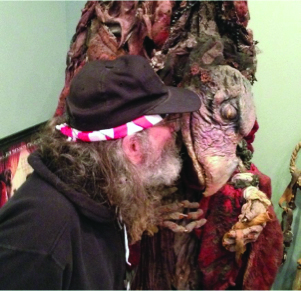
Some feature-movie mixers consider it “beneath them” to work on TV movies, commercials, documentaries, reality shows, etc. I work on any kind of show I can get, because there are various advantages, including a certain “cross-fertilization” that occurs, which improves my abilities on all the other production types.
1. I learn certain “quick ’n’ dirty” procedures are applicable to any shoot, e.g., a gel rattling in the wind can be quickly stopped by stretching a bungee cord (or two in series) across it and wedging a plastic drinking cup between them. (But check for any shadows it might throw on the set.)
2. Less-critical projects allow for “experimenting.” If I encounter a problem when I’m on a major feature, and I know a method to solve it that will produce “good-enough” sound, I can’t afford to take a chance trying something new that might provide better sound, but also might fail and require ADR. On a documentary, even such a “failure” will still be acceptable—and if the method succeeds, I know I can use it on features the next time.
3. More than once, someone I worked for on a non-feature job, or an el-cheapo exploitation film, has gotten me on a “big” show.
4. Some of these shoots turn out to be much more interesting and/or fun than I anticipated. On the reality show, The Jim Henson Creature Shop Challenge, I acquired a new girlfriend.
5. Most of them require much more physical activity than just sitting at my cart hour after hour, and help me keep in shape. Although I’m a senior citizen, I’m not an invalid, and can still run around with a 35-pound kit bag strapped to my chest. (Also from the The Jim Henson shoot.)
6. Even internet movies and shorts produced with extremely-low budgets now can be completely “professional,” with camera cranes and full lighting/grip packages. They often provide the opportunity to work from a bag throughout, although I do bring a chair for the long dialog scenes that aren’t walk-and-talk.
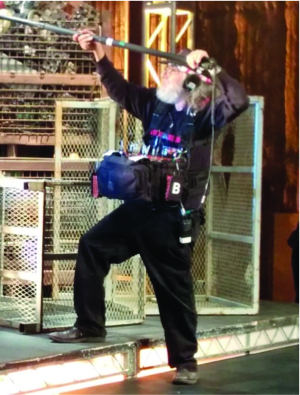
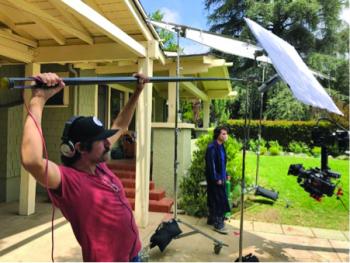
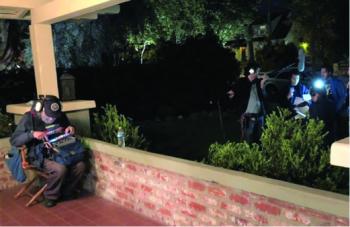
I’M ALMOST OUT OF TAPE, I MEAN MEMORY CARD SPACE
Finally, returning to my initial comment, what is required of sound is not accuracy, but believability. “Verisimilitude trumps veracity” as I am fond of telling my students. And what is “believable” changes from generation to generation, or even more rapidly. When “moving pictures” were first shown in public, a black-and-white film of an approaching locomotive caused a panic in the audience. Now, they know better.
When it comes to sound, there are changes in believability, too. Until fairly recently, most movies were boomed, and perspective sound was the norm. The proximity effect of directional mikes helped to heighten this effect.
Then radio mikes were developed, and soon evolved to be practical—and then ubiquitous. Now, close-miked sound is gradually becoming the new normal. The Laws of Physics have been superseded, too—at least for movies—and now thunder is simultaneous with lightning, the sound of aerial fireworks with the flash, etc.
There is another new development—several related ones, actually. Movie theaters have changed, and not for the better. In the “good old days,” they showed only one picture at a time, and were reasonably quiet. Today, multiplexes abound, and you can hear the audio from theaters on either side of yours, not to mention the sound of most of the audience eating popcorn and talking. In some theaters, outside traffic noise intrudes, and even the HVAC systems are not silenced properly. This increase in the noise floor has forced the projectionists to raise the volume of the sound track, either making the loudest portions too loud, or compressing the dynamic range excessively, or both.
As a result, the re-recording mixers have to adjust the release tracks to have the softest sounds above the noise floor of the theater, and then compress them so the loudest levels won’t be above whatever maximum the local authorities have ordained. The new HDR (High Dynamic Range) standards can work for the picture, but not the sound in these venues. As mentioned earlier, you can ride the gain manually during production and produce a track that will have an acceptable dynamic range, but what that range is to be is continually changing.
PLAY IT FORWARD
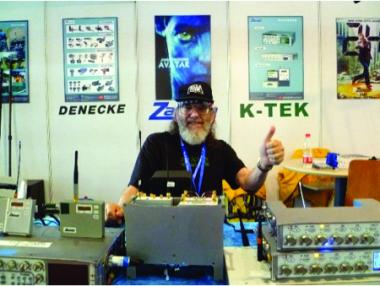
I was very lucky to have my very first day’s recorded ¼-inch tape sent to Lee Strosnider’s transfer house. He realized that the problems were not caused by my incompetence, but rather by defective rental equipment and incorrect instructions in its use. He kindly rented me his own gear, and taught me enough to get started, so I could bootstrap myself up from there. That was the beginning of a 45-year mentoring, which soon became mutual. Many others also helped me along, and eventually I was able to return the favor (though in many cases only Karmically because by then, those people were mixing in more heavenly locations than I was).
Beginning in 1988, I taught sound part-time at UCLA for 25 years, until the department suffered a mission drift and became more interested in making money than having the students learn anything. I’ve also taught at USC, Art Center of Design, LACC, and many other venues.

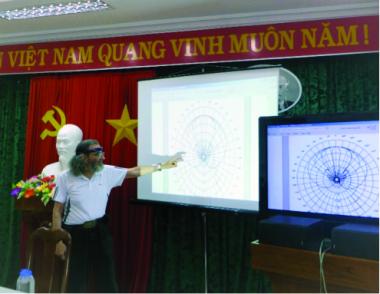
But my mentoring is not completely altruistic—I learn from my students as well. Many years ago, I got a panicked call from a newbie on a ShotMaker camera car who was having a mysterious static problem. After half an hour of remote investigating and experimenting over the phone, we found the trouble was caused by the truck’s electronics package located behind the passenger seat, where the excess mike cable had been coiled on its way to the towed picture car. The very next week, I found myself in exactly the same situation, thanks to my crew who had rigged the cables via the same route. I took me only ten seconds to correct the problem.
There are many other advantages to disseminating knowledge. In 1984, when Nagra released their first timecode recorder, the IV-STC, the manual that came with it was primitive and not particularly useful, especially to a user that had no familiarity with timecode. When I complained, I was told: “If you don’t like our manual, write one yourself.” With the help of the late Manfred Klemme, the Hollywood Nagra rep, we produced a thin tome that I titled Using Timecode in the Reel World. It was an instant hit (not in the least because it was free), but the IV-STC customers wanted even more information, particularly about timecode in general. I did most of the work on the Second Edition of UTCitRW, with Manfred providing the printing and distribution. At that point, he had no more time to spare for this enterprise, so I took over completely with the vastly-enlarged Third Edition, and sold it for $29.95. The cost didn’t discourage the purchasers, and I netted over $5,000 in the following years, until timecode was so well-known that the book was no longer needed. I also wrote articles for Mix magazine.
Now that I was a “published author,” as well as a “university professor,” new doors opened for me, and in 1995 I was invited to Japan to present a technical paper at an international symposium on production recording (InterBEE95).
More recently, in 2010 and 2011, I was sent to China to sell American-made sound gear to Chinese mixers, and since I had worked on the last three years of Avatar, I was a celebrity, as well as an authority. Everywhere I went, women wanted to have their picture taken with me. (And other things, but I’m monogamous.)
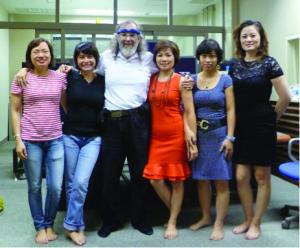
In 2012, I went to Viet Nam to train audio engineers for VTV, the state-run TV network, and was paid $17,075 plus expenses for the 6-week trip. (I would have gone for free, but I didn’t tell them that.)
I’m not being sexist—there are large numbers of women in scientific, technical, medical, and managerial positions in Viet Nam.
At present, I continue to mentor by taking phone calls from other mixers, giving advice and feedback to equipment manufacturers, and writing articles for Production Sound & Video magazine.
THAT’S A WRAP
To wrap up, in the early ’80s, if I remember correctly, I got a call for an interview for a low- budget feature. Thanks to a production office screw-up, another production mixer arrived at the same time. The secretary was embarrassed, but there was no problem—it was Bruce Bisenz, with whom I was on friendly terms.
I got in to see the director first. Soon after the interview started, he told me that he didn’t want “good sound,” and explained: “I’m tired of the re-recording mixers messing up my sound. I want the background sounds, birds, traffic, stuff like that, mixed in with the dialog so they can’t change it from the way I want it.”
This was against everything I had learned so far, because not only could unexpectedly-low level dialog not be pulled up without increasing the ambient sounds, and thus calling attention to the change, but many backgrounds, like traffic, were unpredictable, and could suddenly drown out an otherwise wonderful performance. I had recently bought a new Nagra IV-S recorder (2-track/stereo, but before timecode) and politely suggested that I could record the ambient sounds separately from the dialog, so he could adjust the relative levels to his liking later, and then mix them together before giving the mono track to the editor.
“Thanks, but no thanks. Don’t call us—we’ll call you,” was his reply, though more judiciously put.
I think Bruce overheard all this, and told the director exactly what he wanted to hear, because when I ran across him somewhat later, he told me he got the job. Then the project folded.
Text and pictures ©2019 by James Tanenbaum CAS, all rights reserved.